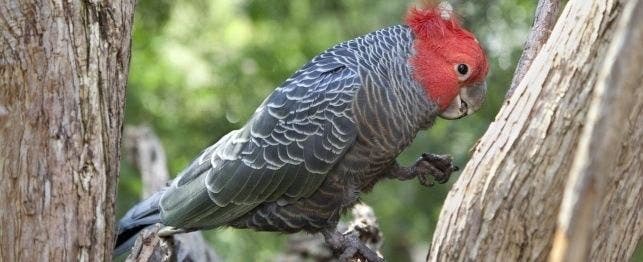
Choosing a Gang-Gang Cockatoo
The gang-gang cockatoo (Callocephalon fimbriatum) is a charming small gray cockatoo similar in size to the rose-breasted cockatoo. Gang-gangs have a wispy recurved crest that is bright red in the male and gray in the female. Both have scalloping, which is faint in the male, yellow-orange in the female.
Gang-gangs are found in the coastal highland forests of southeastern Australia, inhabiting eucalyptus forests, especially along rivers, and feeding on seeds of eucalyptus and other trees, the larvae of wood- boring insects and pyracantha seeds and berries.
Gang-gangs are not common captivity, except in zoos and specialized private collections. Their rarity outside of Australia makes it unlikely they will be available for pets.
Still, the birds are very tame and gentle by nature. They are relatively quiet, save for a pleasant squeaky call. They are inquisitive and love to chew objects in their surroundings – their beaks were designed for chewing trees and are very powerful. They are very destructive if allowed to perch on furniture and should be provided with toys, blocks of wood or branches of nontoxic trees.
Gang-gangs and other cockatoo species can be very long-lived (probably around 50 years), but their precise life span is unknown.
Feeding
Gang-gang cockatoos are efficient in using calories and are not likely to become obese. They should be fed a formulated (pelleted or extruded) diet supplemented with fresh fruits and vegetables daily to add variety and psychological enrichment. Feed approximately 1/3 cup of formulated diet and 1/3 cup of fresh fruits and vegetables daily. Also offer two or three nuts, such as almonds, filberts or macadamias daily. Supplementation with cooked meats may be important for breeders.
Breeding
Breeding age is 4 to 5 years, but gang-gangs are difficult to breed in captivity. Clutch size is typically two to three eggs. A suspended cage is recommended, suggested size is 10 feet by 5 feet by 5 feet.
Incubation period is approximately 27 to 30 days. Gang-gangs are difficult to hand-rear; this should only be attempted by very experienced hand-feeders. Ideally, chicks should be parent reared to avoid imprinting. High-protein, high-fat diets may be needed. Gang-gang chicks are often afflicted with rickets.
In southern states, outdoor caging must be protected from opossums to prevent exposure to the parasite Sarcocystis falcatula, which can result in a fatal lung infection.
Common Diseases and Disorders
Cockatoos are relatively healthy birds but are susceptible to the following:
- Feather picking
- Psittacosis
- Rickets
- Sarcocystis (lung infection)